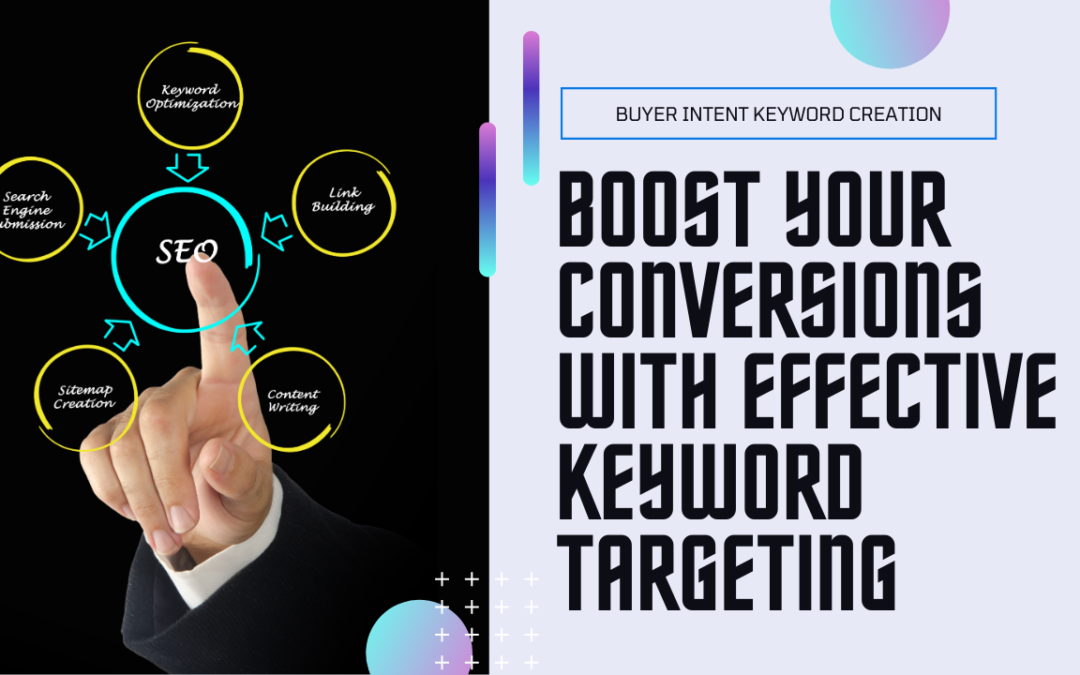Why Buyer Intent is the Key to Winning at SEO
Imagine you’re looking up something as simple as “where to buy coffee beans.” You could be hunting for local stores, researching the best types of beans, or even ready to click “buy now” and have them delivered to your doorstep. This is a perfect example of buyer intent — the underlying reason behind each search.
In Australia, where 93% of online sessions begin with a search engine, understanding buyer intent is essential. Knowing why someone searches helps you provide the most relevant content and products, driving more clicks, engagement, and conversions. If you’re a business owner or content creator, aligning your keywords with buyer intent is one of the most effective ways to attract the right audience at the right time.
Let’s break down the three types of buyer intent — informational, navigational, and transactional — and see how understanding these can help you create content that resonates, converts, and ultimately drives success.
What is Buyer Intent?
Why Knowing Buyer Intent Matters for SEO and Conversions
Buyer intent is the primary purpose behind a user’s search. When someone searches on Google, they have a specific intention — whether it’s to learn, to find a particular website, or to make a purchase.
Aligning your content with this intent is crucial for SEO. When your content matches what the user is looking for, Google and other search engines are more likely to rank your page higher. For example, if someone is searching for “best coffee grinders,” they likely have an informational intent — they’re researching and comparing products, rather than looking to buy right away.
The key takeaway? Knowing the intent behind a search term lets you meet users where they are in their journey, ultimately increasing conversions and reducing bounce rates. So, how do you recognise these intents and leverage them in your content strategy? Let’s start by diving into each type.
Informational Keywords
What Are Informational Keywords?
Informational keywords are used by users who are seeking knowledge or answers to questions. They want to learn something specific but aren’t necessarily looking to buy or convert yet. Examples of informational keywords might include “how to make latte art,” “benefits of organic coffee,” or “what is cold brew.”
In Australia, 64% of online consumers begin their buying journey by gathering information first. This means that informational content is your chance to engage with a broad audience and build trust without asking for anything in return.
Characteristics of Informational Keywords
Informational keywords are generally question-based or follow a “how-to” format. They’re often longer, more detailed, and can help draw a large audience to your content. This type of keyword typically appeals to users in the awareness stage of the buying process.
Examples:
- “how to reduce energy bills in Australia”
- “what is buyer intent”
- “benefits of renewable energy for businesses”
Best Practices for Using Informational Keywords
Creating Educational Content
Informational keywords are best suited for blog posts, articles, explainer videos, and guides. The goal is to educate rather than sell, providing valuable insights without pushing a product.
Providing Value
Focus on high-quality, in-depth content that addresses the user’s question thoroughly. Adding tips, detailed instructions, and even visuals can make your content stand out, especially in competitive niches.
Using Long-Tail Keywords
When targeting informational intent, it’s smart to go after long-tail keywords. For instance, instead of targeting “SEO tips,” try a more specific keyword like “SEO tips for Australian e-commerce stores.” Long-tail keywords tend to attract a highly engaged audience looking for specific answers.
Examples of Informational Keyword Strategies
- “How-To” Articles: Write step-by-step guides that cover frequently asked questions in your industry.
- Utilise Google’s “People Also Ask” Feature: This feature shows common queries related to your topic and can inspire valuable content ideas.
- Use Structured Data for Better Search Visibility: Structured data can help Google understand your content better and potentially land your page in a featured snippet.
Navigational Keywords
What Are Navigational Keywords?
Navigational keywords are used when users want to navigate directly to a specific site or page. This intent is generally tied to brand awareness or familiarity — the user knows what they’re looking for, they just need help getting there. Examples include “eBay login,” “Telstra support,” or “Nike running shoes.”
In Australia, brand loyalty is strong, with 72% of consumers saying they are more likely to buy from brands they are familiar with. Navigational searches are particularly valuable for brands aiming to retain and re-engage their audience.
Characteristics of Navigational Keywords
Navigational keywords are usually branded terms or site-specific phrases. These searches typically come from customers already familiar with the brand, looking for specific pages or content. Navigational keywords are less competitive in SEO terms but crucial for brand recognition.
Examples:
- “Netflix Australia”
- “CommBank login”
- “Telstra customer service number”
Best Practices for Using Navigational Keywords
Optimising Brand-Specific Pages
Ensure that your homepage, support, and product pages are fully optimised for your brand name and other navigational keywords. This includes using the brand name in title tags, meta descriptions, and throughout the page content.
Creating Landing Pages for Popular Searches
If certain searches repeatedly lead users to your site, consider creating dedicated landing pages to match these specific needs. For example, “Contact [Your Brand] Support” can be a dedicated page, helping users find the information they need quickly.
Owning Your Branded Search
Branded keywords are essential to ensuring people find your business, especially if there are similarly named competitors. By optimising for all variations of your brand name, you can keep users from inadvertently visiting competitor sites.
Examples of Navigational Keyword Strategies
- Location-Specific Pages: If your brand has multiple locations, create individual landing pages for each one. For example, “Telstra Store Sydney.”
- Customer Service Pages: Many people search for support, so optimise your help and FAQ pages with relevant navigational terms.
- Branded PPC Ads: Use PPC (pay-per-click) to target branded searches, ensuring you appear at the top when users search for your company.
Transactional Keywords
What Are Transactional Keywords?
Transactional keywords are used when a user is ready to take action, whether it’s purchasing a product, signing up for a service, or booking an appointment. These keywords signal strong buying intent and are usually highly competitive. Examples include “buy iPhone 14,” “best hotel in Sydney,” or “sign up for Netflix free trial.”
With 30% of online searches leading to a purchase in Australia, transactional keywords are invaluable for businesses looking to drive sales directly from search.
Characteristics of Transactional Keywords
Transactional keywords are often action-oriented, containing words like “buy,” “order,” “get a quote,” “free trial,” or “book now.” These terms are highly valuable because they target users who are ready to convert.
Examples:
- “buy coffee grinder online”
- “sign up for streaming service free trial”
- “order takeaway near me”
Best Practices for Using Transactional Keywords
Creating Conversion-Focused Landing Pages
For transactional intent, your landing page needs to focus on converting the visitor into a customer. This might include product pages, pricing pages, and checkout pages that are straightforward, compelling, and optimised to convert.
Clear Call-to-Actions (CTAs)
Strong CTAs are essential for transactional keywords. Phrases like “Buy Now,” “Order Here,” or “Get Your Free Quote” guide users toward taking immediate action.
Incorporating Social Proof and Urgency
To further motivate the user, add elements of social proof like reviews, ratings, and testimonials. Creating urgency with language like “Limited Time Offer” or “Only a Few Left” can also enhance conversions.
Examples of Transactional Keyword Strategies
- PPC Campaigns: Paid ads can be particularly effective for transactional keywords, especially when promoting high-converting products.
- Product Comparison Pages: If you sell multiple versions of a product, create comparison pages to help users make a quick decision.
- Retargeting Ads: Use transactional keywords to retarget users who have shown intent but haven’t converted yet, driving them back to the site.
Integrating All Three Keyword Types in a Content Strategy
How to Use a Balanced Keyword Strategy for Optimal Results
Each type of buyer intent plays a role in the customer journey. A balanced content strategy will include informational keywords to attract a broad audience, navigational keywords to help returning users find what they need, and transactional keywords to drive conversions.
Mapping Keywords to the Buyer Journey
- Awareness Stage: Use informational keywords to educate users and introduce them to your brand.
- Consideration Stage: Navigational keywords come into play as users start to look more closely at your brand.
- Decision Stage: Transactional keywords are ideal for users who are ready to make a purchase or sign up.
Examples of Successful Content Funnel Strategies
- Content Repurposing: Turn high-ranking informational content into transactional content by linking to product pages or including CTA banners.
- SEO Audits: Regularly check your site’s performance for each type of keyword to optimise for search intent and conversion.
To Finish Up
Understanding buyer intent and using informational, navigational, and transactional keywords effectively can make a big difference in your SEO and conversion rates. By creating content that aligns with each type of intent, you can attract, engage, and convert users throughout their entire journey, building brand loyalty and driving sustainable growth.
I hope this serves you,
 Red
Red
Drop us a Line 📞 🗝 (02) 42444411
Follow Us on Social ⏬⏬








